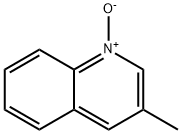3-Picoline-N-oxide
Synonym(s):3-Methylpyridine 1-oxide;3-Picoline N-oxide
- CAS NO.:1003-73-2
- Empirical Formula: C6H7NO
- Molecular Weight: 109.13
- MDL number: MFCD00006203
- EINECS: 213-714-4
- SAFETY DATA SHEET (SDS)
- Update Date: 2025-01-27 09:38:02

What is 3-Picoline-N-oxide?
Chemical properties
PALE YELLOW TO BROWN CRYSTALLINE LOW MELTING MASS
The Uses of 3-Picoline-N-oxide
An intermediate in the preparation of nicotine derivatives.
Purification Methods
Purify the N-oxide by careful fractionation in vacuo. The distillate remains supercooled for several days before solidifying. It is a slightly hygroscopic solid which could melt in the hand. The picrate has m 149-151o (from EtOH). [Taylor & Corvetti Org Synth Coll Vol IV 654 1963, IR: Katritzky et al. J Chem Soc 3680 1959, Jaffé & Doak J Am Chem Soc 77 4441, 4481 1955, Boekelheide & Linn J Am Chem Soc 76 1286 1954]. [Beilstein 20 III/IV 2719, 20/5 V 517.]
Properties of 3-Picoline-N-oxide
| Melting point: | 37-39 °C(lit.) |
| Boiling point: | 150 °C15 mm Hg(lit.) |
| Density | 1.13 |
| refractive index | 1.5444 (estimate) |
| Flash point: | >230 °F |
| storage temp. | Sealed in dry,Room Temperature |
| solubility | >2000g/l |
| pka | pK1:10.921(+1) (25°C) |
| form | Crystalline Low Melting Mass |
| color | Pale yellow to brown |
| Water Solubility | soluble |
| Sensitive | Hygroscopic |
| BRN | 106327 |
| CAS DataBase Reference | 1003-73-2(CAS DataBase Reference) |
| NIST Chemistry Reference | Pyridine, 3-methyl-, 1-oxide(1003-73-2) |
| EPA Substance Registry System | Pyridine, 3-methyl-, 1-oxide (1003-73-2) |
Safety information for 3-Picoline-N-oxide
| Signal word | Warning |
| Pictogram(s) |
 Exclamation Mark Irritant GHS07 |
| GHS Hazard Statements |
H315:Skin corrosion/irritation H319:Serious eye damage/eye irritation |
| Precautionary Statement Codes |
P264:Wash hands thoroughly after handling. P264:Wash skin thouroughly after handling. P280:Wear protective gloves/protective clothing/eye protection/face protection. P302+P352:IF ON SKIN: wash with plenty of soap and water. P305+P351+P338:IF IN EYES: Rinse cautiously with water for several minutes. Remove contact lenses, if present and easy to do. Continuerinsing. P332+P313:IF SKIN irritation occurs: Get medical advice/attention. P337+P313:IF eye irritation persists: Get medical advice/attention. |
Computed Descriptors for 3-Picoline-N-oxide
3-Picoline-N-oxide manufacturer
Lorven Biologics Pvt Ltd
1Y
Phone:+91-8884110005
Whatsapp: +91-8884110005
product: 1003-73-2 3-methyl pyridine N-oxide 98%
New Products
4,4-Difluoropiperidine hydrochloride tert-butyl 9-methoxy-3-azaspiro[5.5]undecane-3-carboxylate Indole Methyl Resin N-Isopropylurea N,N-Dicyclohexylcarbodiimide(DCC) MELDRUMS ACID 5-METHYLISOXAZOLE-4-CARBOXYLIC ACID Magnessium Bis glycinate Zinc ascorbate 1-bromo-2-butyne 2-acetamidophenol 9(10H)-anthracenone Erythrosin B, 4-Piperidinopiperidine 2-((4-morpholinophenylamino) (methylthio) methylene) malononitrile 2,4-dihydroxybenzaldehyde 3-(4-morpholinophenylamino)-5-amino-1H-pyrazole-4-carbonitrile Methyl 2-methylquinoline-6-carboxylate 2,6-dichloro-4-nitropyridine 4-Bromo-2-chlorobenzonitrile 2-(benzylamino)acetic acid hydrochloride 4-(tert-Butoxycarbonylamino)but- 2-ynoic acid 3,4-dihydro-2H-benzo[b][1,4]dioxepine 1-Phenyl-1-cycloprppanecarboxylicacidRelated products of tetrahydrofuran




![2,6-BIS[(4-CHLOROPHENYL)SULFONYL]-3-CYANO-4-METHYLPYRIDINIUM-1-OLATE](https://img.chemicalbook.in/StructureFile/ChemBookStructure2/GIF/CB8405416.gif)



You may like
-
 1003-73-2 98%View Details
1003-73-2 98%View Details
1003-73-2 -
 3-Methylpyridine-N-oxide 99%View Details
3-Methylpyridine-N-oxide 99%View Details
1003-73-2 -
 B-Picoline-N-oxide 98%View Details
B-Picoline-N-oxide 98%View Details
1003-73-2 -
 1003-73-2 98%View Details
1003-73-2 98%View Details
1003-73-2 -
 3-Picoline-N-oxide, 98% CAS 1003-73-2View Details
3-Picoline-N-oxide, 98% CAS 1003-73-2View Details
1003-73-2 -
 3-Picoline N-oxide, 98% CAS 1003-73-2View Details
3-Picoline N-oxide, 98% CAS 1003-73-2View Details
1003-73-2 -
 3-Methylpyridine N-Oxide CAS 1003-73-2View Details
3-Methylpyridine N-Oxide CAS 1003-73-2View Details
1003-73-2 -
 3-Methylpyridine-N-oxide 98%View Details
3-Methylpyridine-N-oxide 98%View Details
1003-73-2
Statement: All products displayed on this website are only used for non medical purposes such as industrial applications or scientific research, and cannot be used for clinical diagnosis or treatment of humans or animals. They are not medicinal or edible.
